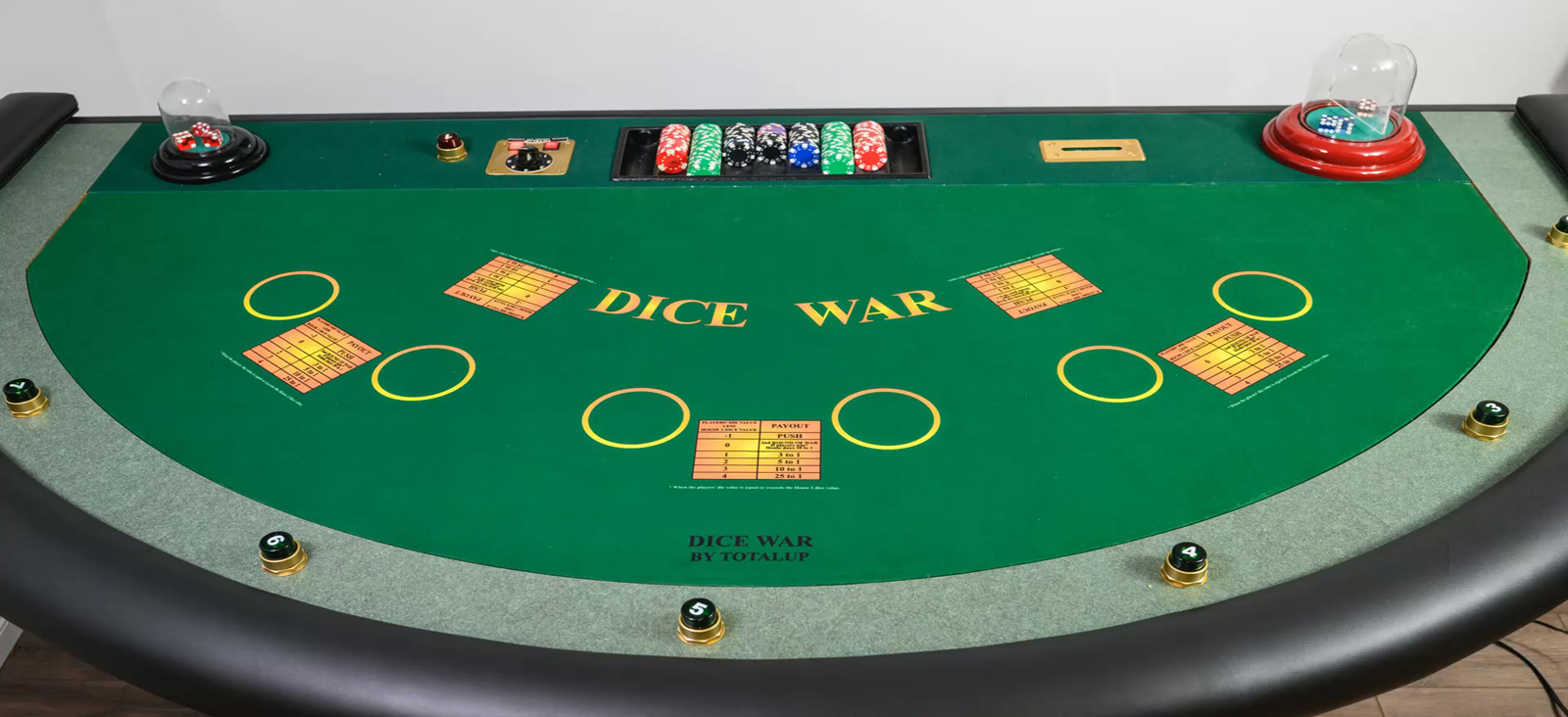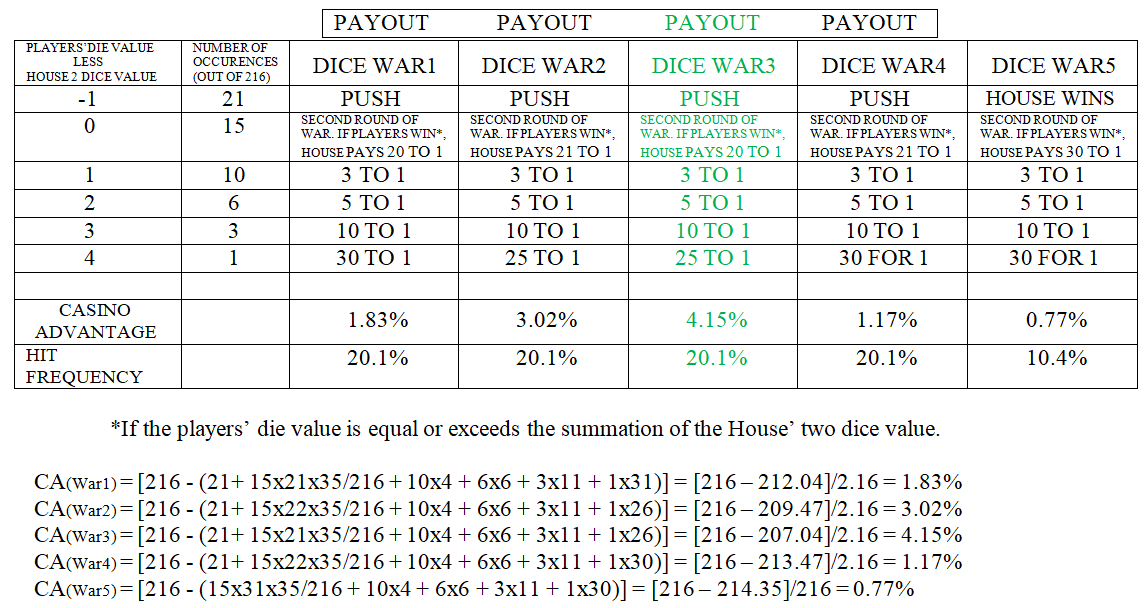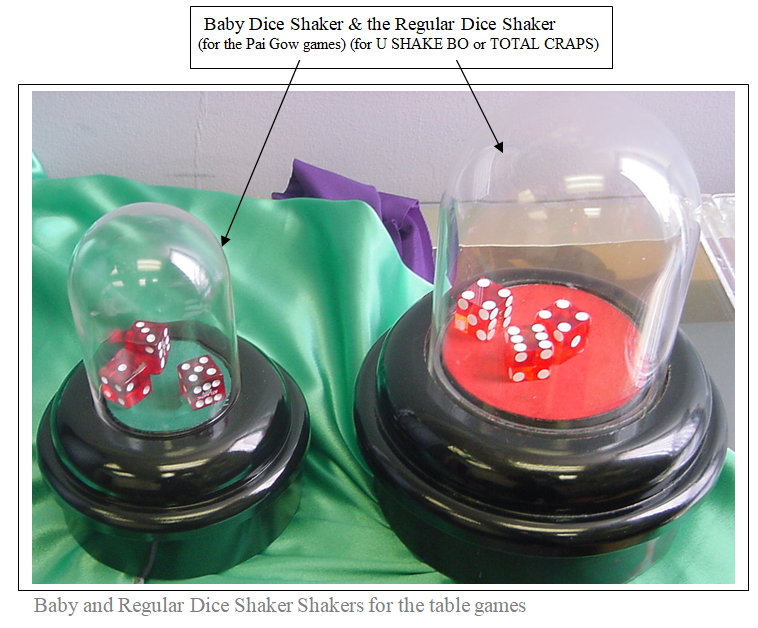DICE WAR
DICE WAR
DICE WAR
The majority of the casino games (tables and slots) are card based games and only very few are dice games. Craps and Sic Bo are probably the only dice games in casinos. While craps is the most popular dice game in North America but hardly known in Asia, Sic Bo is the most popular dice game in Asia but uncommon in North America.
“DICEWAR” is a name of a new simple gambling dice game for casinos and for playing games of chance. DICEWAR is designed to attract craps, Sic Bo and dice lover players.
DICEWAR is designed as a very simple dice game to attract casual gamblers seeking primarily entertainment who usually want to be entertained and not trained and do not wish to commit a high level of concentration and mental activity to the game. Even though a few of DICEWAR features are common to those of Craps and Sic Bo games, it is quite different from them. Unlike Craps and Sic Bo, where players play against a table payout and schedule, players in DICEWAR roll their die and compete against the House die or dice. Unskilled players can participate and enjoy playing the game as they do not have to make any decision during any round of the game. DICEWAR is a simple play, and a game of pure chance.
GENERAL GUIDE AND RULES OF PLAY, preferred version
The game is played with 3 dice, usually contained in a dice shaker. The shaker is divided into two compartments; one contains 2 House dice and the other contains the Players’ Die. Each player places a wager at the start of the round. Players’ die value is determined by the indicia of the Players’ die and the House dice value is determined by the summation of the two indicia of the House dice. Players win, push or lose according to the two values of the two sets of dice and a predetermined payout schedule.
- Each player places a wager in the circular post; each wager has to be within the minimum- maximum limits posted at the table and each wager can vary within those limits.
- The dealer then allows one of the players to push a button and activate the dice shaker. Due to the partition within the dice shaker, the Players’ die and the House dice never mingle and they are always kept separate. After a few seconds, typically 4 to 6 seconds, the shaker stops and all the three dice lay flat at the bottom of the shaker each displaying one value 1, 2, 3, 4, 5 or 6. The objective of the players in the game is to win and beat the house by having the players die value about equal or greater than the house 2 dice total value.
- Once the shaker has stopped and the 3 dice settle on the flat surface of the shaker, the dealer compares the Players’ die value to the total house two dice value. Table 1 gives 5 payout scenarios. In the first 4 scenarios, if the House dice total value exceeds the Players die value by more than one point, then the dealer collects all wagers, if the Players die value is one point less than the house 2 dice total value then it is a push, if the Players die value exceeds the House 2 dice total value, the players win and are paid accordingly, and if the Players die value is equal to the House 2 dice total value then it is a second round of war. The shaker is then activated for the second round of war. If the House’ dice value is greater than the players’ die value, then the dealer collects all wagers, otherwise players are paid accordingly. The hit frequency which includes “Push” in all these four scenarios is 20.1%. In scenario 5, the house wins if the players’ die value is one point less than the summation of the house two dice value.
Once all bets are resolved, new wagers are made and the process starts again. A new round begins. Table 1 gives a summary of $1 bet settlement for these four scenarios.

TABLE 1: DICE WAR PAYOUT SCHEDULE, HIT FREQUENCY AND CASINO ADVANTAGE
THE BABY SHAKER IN THE PAI GOW GAMES
In addition to the regular shaker being used in games like the U SHAKE BO or TOTAL CRAPS, TOTALUP has introduced the Baby Shaker to add more excitement to the Asian games such as Pai Gow Poker or Pai Gow Tiles. In those games, the Baby Shaker is operated in turn by the dealer or by one of the players, the outcome of which determines who gets the first stack of tiles or the first set of cards. It actually replaces, in the Pai gow tiles game, the small container with the three dice manually rolled by the dealer, or as allowed in a few of the casinos, by a player but only when that player is the banker. In the Pai Gow poker it meant to be an alternative to the random number generator operated by the dealer alone.
When the dealer acts as banker, which is usually the case, the players are given in turn the option to push the button, i.e. starting from #1(dealer), player #2, 3,….till 7 and then it all starts all over again. Every player has the choice to refuse to push the button and if that happens then the operation of the dice shaker is passed on to the next player in turn. At any round, each player may have the right to act as banker and may have the first choice to also be the player that will push the button. The noted player may waive his or her right to push the button to the next player in turn.
The use of the Baby Shaker and the associated Push Button Control Unit in a Pai Gow game, is not changing in any way the conventional game, but provides more flexibility and adds more options to the players.




